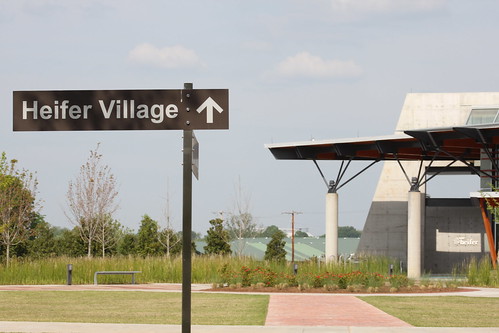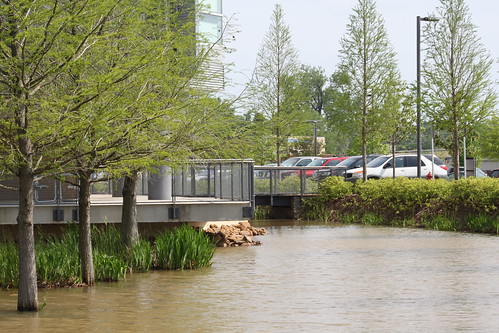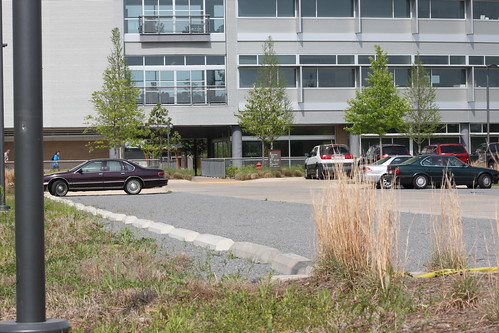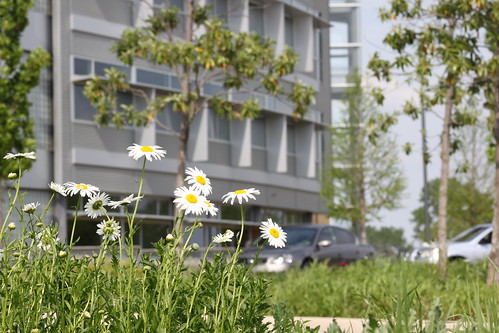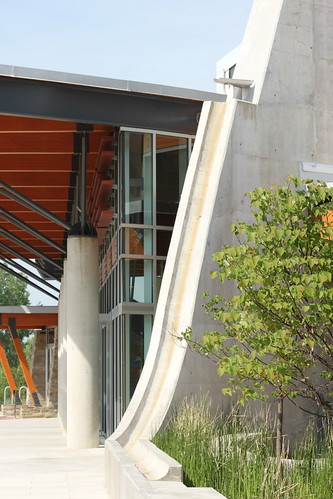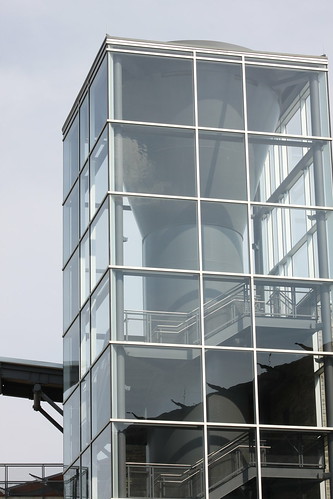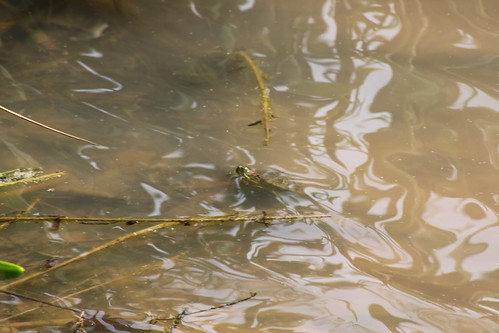cross-posted from Sum of Change
The Heifer International Headquarters in Little Rock, Arkansas is one of the greenest buildings in the world, by many standards. Since my drive across the country was bringing me right through Little Rock, I had to drop in to see this.
First, you should understand who Heifer International is. They are a non-profit that works in struggling communities throughout the world to provide people with tools to improve their lives. Often that includes livestock and training in a unique loan agreement where one of the livestock's offspring is to be given to another needy family. They call that "Passing on the Gift – a cornerstone of our mission that creates an ever-expanding network of hope and peace."
While doing this work it struck them that it would all be in vain if we, as a society, do not take proactive steps to make all our communities more sustainable. “If we’re going to have a lasting impact on ending world hunger, then everything we do must renew the earth and not deplete it,” said Jo Luck, Heifer’s president and CEO.
Everything about this building, from the initial plot of land to what we have today, was highlighted by sustainability. The site they chose to build on was picked because it was what is called a brownfield site. Before anything could be done, the place had to be cleaned. They hauled off 75,000 tons of earth, and made the site into a wetland.
They used as much of the material that was there as possible, grinding up concrete from abandoned buildings to make gravel for the construction process. They relied on local businesses for many materials, such as Ace Glass Co who are literally across the street. They used bamboo for the wood floors which grows rapidly and is recyclable. The rugs are recycled carpeting, that can themselves be recycled. They are designed in squares, like tiles, so that money and resources can be saved by replacing squares when damage is done and not the whole rug.
The wetland area "controls, stores and reuses surface groundwater." To prevent pollution in the water, there is "an innovative, permeable-surface parking lot next to the building eliminates common stormwater runoff problems."
They also use gravel to filter liquids that drop off parked cars:
Wild flowers are allowed to grow freely in parking lot medians so roots grow far and create another natural filter:
The roofs catch water, are white to avoid evaporation, and are made out of a type of pool surface that makes the water bead easier. Of course, all the water is collected and reused:
That water is dumped into a filter that, at first glance, appears to be no more than some stones and vegetation:
And, of course, to keep all this water they have a four story water collection tower:
This does not provide drinking water but could be retrofitted to filter to that high a degree.
These measures have created a wetlands that now serves as home to some animal friends. Fish were added early on, but turtles and birds have moved in on their own and apear to be thriving.
Moving inside, you immediately notice how long and narrow the building is. It is only 64 feet wide for a very specific reason: sunlight. Windows can provide decent sunlight up to approximately 30 feet in. The narrow building allows everyone inside to rely heavily on sunlight. The building is then positioned so that the sun is never facing the two long walls. This way you have no direct sunlight making certain rooms hotter than others. The indoor lights are on sensors and become lighter or darker depending on how bright it is outside.
The building uses a creative heating and cooling system, venting from the floor and not the ceiling. They have high ceilings and venting from the floor allows them to only heat and cool the bottom part of the room, saving energy that would otherwise be wasted on space no one will ever occupy.
Moving back to the roofs, we learn that they are slanted in relation to the position of the sun so as to grab more heat from the sun in the winter months and less in the summer:
The Heifer International Headquarters teaches us that a little green architecture and some good intentions can go a long way to developing a more sustainable society. This building uses over 50% less energy than buildings of comparable size and use.
Friday, April 16, 2010
Tips and Tales from the Road
KYou may or may not know that yesterday I took off for a cross-country road trip!!! Anyways, I'll be visiting some great places and meeting up with some great people over the next few weeks. I'll try to keep you all updated along the way.
Just got in to my first motel 6 on the trip, so now sounds like a good time for some road tripping Urquhart-style trips.
1: This actually comes from my brother, and is really a cooler tip, but I brought a cooler of food so it is relevant. Before you buy ice or ice-packs, try freezing some water bottles, or even stuff like vitamin water and gatorade. Once frozen, these bottles will work to keep the cooler cold just as well as ice or ice-packs. The great thing is they don't leave a huge pool of water to dump out when they melt, and you don't lose valuable cooler space. I swear, try it once and you will be hooked. Sadly, my motel six has no fridge in the room, but they have free ice and if it wasn't late I would fill my empty bottle with ice instead of just dumping it in the cooler.
2: Before you leave, ask a handful of friends what the last three bands they listened to are, then go out and get as much of it as you can. I was able to find complete discographies for most of the bands my friends mentioned, loading my Droid with oodles of new albums. You can also then pump all the bands your friends mentioned into a playlist on Pandora, creating a huge list unique to that specific road trip.
3: The Droid rocks. Okay not really a tip but it does. I just finished writing this and published it from the Droid.
Just got in to my first motel 6 on the trip, so now sounds like a good time for some road tripping Urquhart-style trips.
1: This actually comes from my brother, and is really a cooler tip, but I brought a cooler of food so it is relevant. Before you buy ice or ice-packs, try freezing some water bottles, or even stuff like vitamin water and gatorade. Once frozen, these bottles will work to keep the cooler cold just as well as ice or ice-packs. The great thing is they don't leave a huge pool of water to dump out when they melt, and you don't lose valuable cooler space. I swear, try it once and you will be hooked. Sadly, my motel six has no fridge in the room, but they have free ice and if it wasn't late I would fill my empty bottle with ice instead of just dumping it in the cooler.
2: Before you leave, ask a handful of friends what the last three bands they listened to are, then go out and get as much of it as you can. I was able to find complete discographies for most of the bands my friends mentioned, loading my Droid with oodles of new albums. You can also then pump all the bands your friends mentioned into a playlist on Pandora, creating a huge list unique to that specific road trip.
3: The Droid rocks. Okay not really a tip but it does. I just finished writing this and published it from the Droid.
Wednesday, April 14, 2010
[Livefeed] David Waldman on Process And Lessons Learned Fighting for Health Care
cross-posted from Sum of Change
Today we were fortunate to be joined by David Waldman, a Contributing Editor at Daily Kos and the Editor-in-Chief of Congress Matters. This interview was recorded live, starting at 2:45pm (EST). We spoke about the legislative process and lessons learned from fighting for health care reform.
David Waldman's analysis of process during the fight for reform was among the most substantial analysis coming out of the netroots. Bloggers like myself relied heavily on his insight to help better understand where we were and the road ahead. And this recent fight forced us to examine a multitude of congressional processes in ways we have not for a very long time. We we are very excited to hear what Mr. Waldman has to say about the lessons we learned.
UPDATE: I wanted to highlight a few of the lessons learned that David shared with us, especially for the video-impaired amongst us. These are not direct quotes, just my observations:
Today we were fortunate to be joined by David Waldman, a Contributing Editor at Daily Kos and the Editor-in-Chief of Congress Matters. This interview was recorded live, starting at 2:45pm (EST). We spoke about the legislative process and lessons learned from fighting for health care reform.
David Waldman's analysis of process during the fight for reform was among the most substantial analysis coming out of the netroots. Bloggers like myself relied heavily on his insight to help better understand where we were and the road ahead. And this recent fight forced us to examine a multitude of congressional processes in ways we have not for a very long time. We we are very excited to hear what Mr. Waldman has to say about the lessons we learned.
UPDATE: I wanted to highlight a few of the lessons learned that David shared with us, especially for the video-impaired amongst us. These are not direct quotes, just my observations:
1) There is a role that the netroots needs to grow into that moves us beyond our traditional model of advocacy by sheer numbers alone.
2) One of the things that worked, to a certain extent, was the development of whip counts and the use of highly targeted advocacy, focusing in on very specific pressure points.
3) You need to understand the process in order to effectively lobby your legislator. Specific asks provide more powerful commitments.
4) On purely a legislative level, starting from a spot of compromise was likely a bad idea that in no way softened the opposition.
5) We have a new model for dealing with merging two different bills. In future fights, when we see legislation moving along the "health care model," we already know where to put pressure with advocacy.
6) Almost no major legislation has passed and not been improved upon. Changes will be made. Changes should be made.
Subscribe to:
Comments (Atom)

